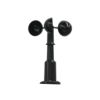YOUNG Wind Sentry Anemometer & Vane
Features
- Anemometer uses three lightweight hemispherical cups to measure wind speed
- Vane employs a balanced assembly with position sensed by a long-life potentiometer
- Precision stainless steel ball bearings are used throughout
- Free ground shipping
- Expedited repair and warranty service
- Lifetime technical support
- More
The YOUNG Wind Sentry Anemometer and Vane are professional quality sensors suitable for a wide range of wind measurement applications. These economically priced sensors provide excellent sensitivity, corrosion resistance, and minimal parts count for easy maintenance.
The anemometer uses three lightweight hemispherical cups to measure wind speed. Cup wheel rotation produces an AC frequency that is linearly proportional to wind speed. The vane employs a balanced vane assembly with vane position sensed by a long life precision potentiometer. Precision stainless steel ball bearings are used throughout.
Range:
Wind Speed: 0-50 m/s (112 mph)
Azimuth: 360° mech.,352° electrical (8° open)
Accuracy:
Wind Speed: ±0.5 m/s (1.1 mph)
Wind Direction: ±5°
Threshold*:
Anemometer: 1.1 m/s (2.5 mph)
Vane: 1.3 m/s (2.9 mph) at 10°
Signal Output:
Wind Speed Signal: AC sine wave, 1 pulse per rev.
Wind Direction Signal: DC voltage from 10Kohm conductive plastic potentiometer, 1% linearity, life expectancy: 50 million revolutions.
Power Requirement: Potentiometer excitation 15 VDC max
Dimensions:
Overall height: 32 cm (12.6 in)
Crossarm Length: 28cm (11.0 in) between instrument centers
Vane length: 22 cm (8.7 in)
Cup wheel diameter: 12 cm (4.7 in)
Crossarm mounting: 34 mm (1.34 in) diameter (standard 1 inch pipe)
Shipping Weight: (03002) 1.3 kg (3 lb)
In The News
Source Water Monitoring in Albany, New York: Tracing Water Quality throughout Tributaries
Thousands of US cities pull their drinking water from natural source waters like reservoirs, rivers, and streams, making overall watershed health a key consideration for water providers. In Albany, New York, the Albany Department of Water and Water Supply delivers drinking water to over 100,000 residents as well as monitors and manages the larger drinking water supply watershed. Hannah Doherty, Environmental Specialist at the Albany Department of Water and Water Supply , spends her days working with a small team to monitor the drinking supply and the connected water bodies. Doherty explains, “We’re the first to encounter the water that ends up being the drinking water.
Read MoreWildfire Prevention in the Sierra Nevada Region with the Yuba Watershed Institute
Though recent wildfires have sparked new conversations about wildfire management and response, groups like the Yuba Watershed Institute have been monitoring the forests and water resources of the Sierra Nevada region for decades, managing approximately 5,000 acres of land with the Bureau of Land Management (BLM) and about 7,000 acres in private land partnerships. The goal of the Institute is to work with local communities and land agencies to improve watershed and forestry management through informed practices and public outreach. The goals of the Yuba Watershed Institute are three-fold: Improve the ability of fire suppression agencies like the California Department of Forestry and Fire Protection ( CAL FIRE ) and the US Forest Service.
Read MoreWave Sensors Integration with NexSens Buoys: A Cutting-Edge Solution for Wave Measurment
Real-time wave data supports accurate weather prediction, safe and efficient maritime operations, and provides valuable safety and operating condition information for recreation and commercial fishing. Understanding wave dynamics also helps with the design of protective coastal structures like seawalls, breakwaters, and jetties. It also supports better prediction of their impact on sediment transport and coastal geomorphology. Wave data is a key factor in qualifying and designing offshore wind farms and harnessing kinetic energy for electrical generation. It helps with the understanding of ocean-atmosphere interactions and contributes to studies of sea-level rise and climate change impacts.
Read More












